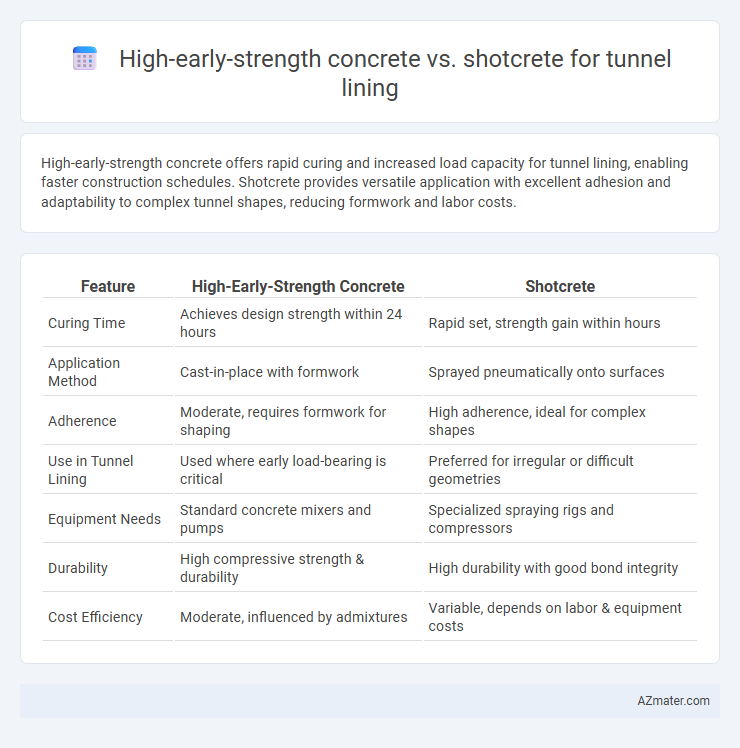High-early-strength concrete offers rapid curing and increased load capacity for tunnel lining, enabling faster construction schedules. Shotcrete provides versatile application with excellent adhesion and adaptability to complex tunnel shapes, reducing formwork and labor costs.
Table of Comparison
| Feature | High-Early-Strength Concrete | Shotcrete |
|---|---|---|
| Curing Time | Achieves design strength within 24 hours | Rapid set, strength gain within hours |
| Application Method | Cast-in-place with formwork | Sprayed pneumatically onto surfaces |
| Adherence | Moderate, requires formwork for shaping | High adherence, ideal for complex shapes |
| Use in Tunnel Lining | Used where early load-bearing is critical | Preferred for irregular or difficult geometries |
| Equipment Needs | Standard concrete mixers and pumps | Specialized spraying rigs and compressors |
| Durability | High compressive strength & durability | High durability with good bond integrity |
| Cost Efficiency | Moderate, influenced by admixtures | Variable, depends on labor & equipment costs |
Introduction to Tunnel Lining Solutions
High-early-strength concrete and shotcrete are essential materials for tunnel lining, offering distinct advantages in construction speed and structural integrity. High-early-strength concrete enables rapid curing and early load-bearing capacity, critical for minimizing downtime in tunnel projects. Shotcrete, applied pneumatically, provides excellent adhesion and adaptability to complex tunnel geometries, enhancing structural stability and waterproofing capabilities.
Understanding High-Early-Strength Concrete
High-early-strength concrete achieves compressive strengths exceeding 20 MPa within 24 hours, making it ideal for tunnel linings requiring rapid load-bearing capacity. Its accelerated hydration process results from optimized mix designs incorporating high cement content and chemical admixtures like calcium chloride or silica fume. Compared to shotcrete, which is sprayed pneumatically and benefits from immediate adhesion, high-early-strength concrete provides superior structural uniformity and long-term durability in tunnel lining applications.
What is Shotcrete?
Shotcrete is a method of applying concrete or mortar through a high-pressure hose, allowing for rapid placement and strong adhesion to tunnel surfaces. This technique is ideal for tunnel lining as it conforms easily to irregular shapes and provides immediate structural support, enhancing stability during excavation. Compared to high-early-strength concrete, shotcrete offers faster application and curing times, making it a preferred choice for underground construction projects requiring quick reinforcement.
Key Material Properties Comparison
High-early-strength concrete exhibits superior compressive strength development within 24 hours, typically reaching 20-40 MPa, which accelerates tunnel lining construction schedules. Shotcrete offers excellent adhesion and adaptability to complex tunnel geometries due to its pneumatically applied process, with compressive strengths ranging from 15 to 30 MPa depending on mix design. The low permeability and enhanced durability of high-early-strength concrete support long-term structural integrity, whereas shotcrete provides versatility and rapid application but may require additional reinforcement for load-bearing capacity.
Installation Techniques and Equipment
High-early-strength concrete for tunnel lining is typically poured using conventional formwork systems and requires standard concrete mixers and pumps designed for rapid curing, enabling faster project turnaround. Shotcrete employs specialized spraying equipment such as robotic or handheld nozzle systems that apply the concrete pneumatically, allowing for flexible application on irregular tunnel surfaces without the need for extensive formwork. Installation of shotcrete demands skilled operators to manage nozzle distance and angle, whereas high-early-strength concrete installation hinges on precise mixing ratios and timely placement to achieve optimal early strength performance.
Strength and Durability Performance
High-early-strength concrete achieves rapid compressive strength gain, typically reaching 20-30 MPa within 24 hours, which accelerates tunnel lining construction and improves initial structural stability. Shotcrete offers excellent adhesion and compaction on irregular tunnel surfaces, providing superior durability by minimizing voids and enhancing resistance to water ingress and chemical attack. The durability of shotcrete is often enhanced with fiber reinforcement and additives, making it highly effective for long-term performance in aggressive underground environments.
Time Efficiency and Construction Speed
High-early-strength concrete accelerates tunnel lining by achieving required strength within 24 hours, enabling faster formwork removal and quicker subsequent construction stages. Shotcrete offers superior time efficiency through rapid application and immediate setting on uneven rock surfaces, reducing the need for formwork. Both methods significantly enhance construction speed, with shotcrete especially advantageous in complex geometries and high-accessibility challenges.
Cost Analysis: Materials and Labor
High-early-strength concrete typically incurs higher material costs due to specialized admixtures and higher cement content, while shotcrete offers savings by reducing formwork expenses and enabling faster application with spraying equipment. Labor expenses for shotcrete are often lower as it requires fewer workers and less curing time compared to conventional high-early-strength concrete placement. Overall, shotcrete can offer a cost-effective tunnel lining solution by minimizing both material usage and labor-intensive processes.
Safety and Environmental Considerations
High-early-strength concrete offers rapid load-bearing capacity, reducing construction time and enhancing worker safety by minimizing exposure to hazardous conditions. Shotcrete application eliminates formwork, decreasing material waste and dust generation, which lowers environmental impact and improves onsite air quality. Both methods require careful handling of additives to prevent chemical hazards, with shotcrete demanding stricter ventilation controls due to airborne particles.
Selecting the Best Option for Tunnel Projects
High-early-strength concrete offers rapid strength gain ideal for tunnel lining in projects requiring quick formwork removal and early load application, while shotcrete provides flexible application on irregular surfaces and complex geometries with reduced formwork needs. Selecting the best option depends on factors like tunnel geometry, project timeline, labor availability, and cost constraints; high-early-strength concrete suits uniform sections with stringent schedule demands, whereas shotcrete excels in variable or hard-to-reach areas requiring adaptability. Optimizing tunnel lining performance involves balancing these material properties with project-specific logistics to ensure structural integrity and efficient construction workflows.

Infographic: High-early-strength concrete vs Shotcrete for Tunnel lining
 azmater.com
azmater.com